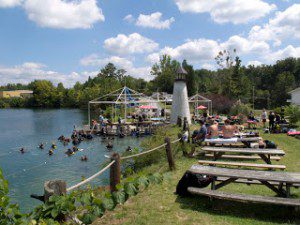Yesterday, I had the pleasure of making a couple dives at Bluestone Dive Resort in Thomasville, North Carolina. It was a pleasure because I got to dive with my dad again, and I got to see a couple old friends and it was a perfect day to be outside enjoying the world. But most importantly, we were diving for a good cause.
| Divers in the water prepare for a shotgun start to hunt golfballs. |
It’s not live yet, but Janet plans to place the prizes that are still left as a silent auction on the Blue Dolphin Dive Center website. I encourage anyone reading to participate in the auction and help out a fellow diver and friend as he fights he way past cancer and the problems that come with it.







